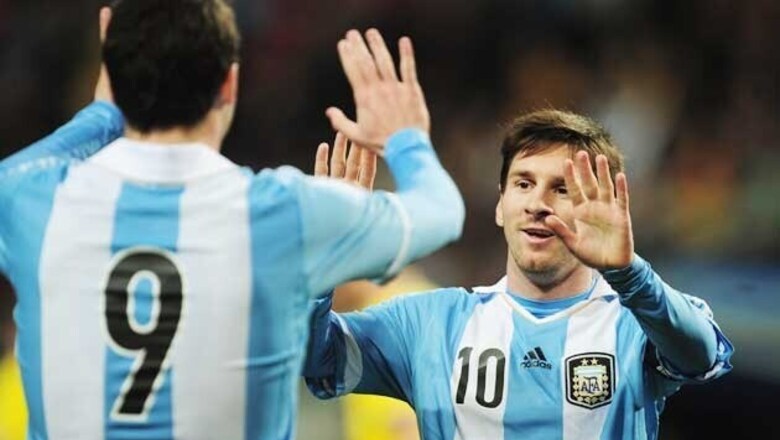
views
Argentina are going to the World Cup in Brazil for the first time looking to correct a big mistake that led to years of national grief after their withdrawal from the 1950 tournament in conflict with the Brazilian Football Confederation.
The most successful of South America's nations in the 1940s, a golden age in Argentine football, they decided against sending a team to defend their Copa America title in Brazil in 1949 and Brazil took offence.
The reason behind this shock decision was a mass exodus of their most talented players, including Alfredo Di Stefano, to the Colombian league outlawed by FIFA during a pay strike by professional players in Argentina in 1948.
"Di Stefano, Pipo Rossi, (Adolfo) Pedernera left. It showed a lot that they were missing," said former River Plate and Argentina goalkeeper Amadeo Carrizo, who will be 88 on June 12 when the 2014 finals kick off.
"Rossi was the midfield general and Di Stefano was in his moment of glory," Carrizo told Reuters in an interview speaking of team mates with whom he played a part in the great River Plate side of the era known as La Maquina (engine).
"Destiny would have it that (doors) were opened for him in another country. It favoured him to go to Real Madrid and enjoy great triumphs," added Carrizo, speaking of Di Stefano, who is also still alive today.
Brazil were miffed by the perceived Argentine snub and did not support their neighbours' bid to bring the World Cup back to the region after the Switzerland finals in 1954, which Argentina also decided to boycott.
The player who most suffered the consequences of this wrong political turn in Argentine football was Carrizo, who was given a torrid time by fans in Buenos Aires when the team returned from the 1958 finals in Sweden, their first in 20 years, where they were eliminated after conceding 10 goals in three group matches.
"We suffered a lot with (what happened) in Sweden and I was the one on the end of the goal glut," said Carrizo, voted the best goalkeeper in South America in the 20th century by FIFA's statistics arm IFFHS.
SWEDISH DISASTER
Carrizo received the accolade despite the so-called "Disaster of Sweden" in which Argentina lost 3-1 to holders West Germany, beat Northern Ireland 3-1 and were crushed 6-1 by Czechoslovakia, their worst ever World Cup result.
"After the (Czechoslovakia) match we shut ourselves up in our hotel and didn't want to go out, no-one forgets something like that. Sometimes they show images of that World Cup on television but I don't even want to see them and change channel," Carrizo said.
"In that World Cup we won only one match, against (Northern) Ireland 3-1, the football played by Czechoslovakia and Germany was at a peak and we had to face them. Ireland also played well, so they were three strong teams."
A pioneer goalkeeper who broke the boundaries of his penalty area as an extra defender and to help launch attacks, Carrizo was an inspiration for the likes of compatriot Hugo Gatti and Colombia's Rene Higuita.
But such a goalkeeper was more exposed by teams bent on attack. Argentina also discovered they had fallen behind in speed to the more athletic and organised Europeans.
"There was the (World) War at that time, there were no meetings with other (European) teams, Argentina didn't even play and we suffered the consequences," he said in a bar in his attractive home neighbourhood of Villa Devoto in the capital.
"We didn't know what was happening in Europe and football was at its peak, in England, Germany, France there was already spectacular progress with great players and we went there and they overran us."
Argentina's victory in the Copa America in Peru in 1957, in which they crushed the Brazil side that would be crowned world champions a year later 3-0, further helped blind them to the progress of the game in Europe.
The inside trio of Humberto Maschio, Antonio Angelillo and Omar Sivori, European Footballer of the Year a few years later, from that Argentina side were all transferred to Italian clubs and were lost to the Argentine team for good.
Unlike Argentina players today, they were not called back home for 1958 World Cup finals and ended up playing for Italy just as Di Stefano did for Spain.
LONG RECOVERY
Argentina lost their way and it took them 20 years to recover from the "Sweden Disaster" with their first World Cup victory in 1978.
They were plunged into an era of negative and occasionally violent football as they tried to catch up with Europe in terms of tactics and physical strength and abandoned their traditional attacking instincts and skills.
Carrizo and the 1958 squad were given a nasty reception on their return from Sweden by fans who, led to believe that the world's best football was being played in Argentina in the 1940s and 1950s, expected no less than the trophy.
He said he turned down the chance to go to the next World Cup finals in Chile in 1962 because "I suffered a lot, nasty things were said to me, my house was daubed with paint, my car almost destroyed.
"People were especially angry with me because I was a showoff but that was a style (of play) that worked well for me, otherwise River would have kicked me out."
Carrizo won back Argentina fans' esteem in the Nations Cup in Brazil in 1964, a four-team tournament in which Argentina won all their matches against the hosts, England and Portugal without conceding a goal and with his penalty save from Gerson in the 3-0 win over Pele's Brazil.
A nice and essentially optimistic man who is modest despite his admission he was a showoff on the pitch, Carrizo was recently made honorary president of River Plate.

















Comments
0 comment